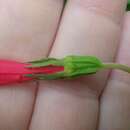Comprehensive Description
provided by North American Flora
Centropogon radicans (Kuntze) McVaugh, Ann. Mo Bot. Card. 27: 353. 1940.
Siplwcampylus radicans Kuntze. Rev. Gen. 381. 1891.
Siphocampylus roseus Donn. Smith, Bot. Gaz. 23: 249. 1897. (Biolley, herb. nat. C.R. 6922, US!) Centropogon coccineus Regel; F. E. Wimmer, .^nn. Naturh. Mns. Wien 46: 241. 1933. Not Siphocampylus coccineiis Hook., 1845.
Terrestrial, herbaceous, the stems trailing, rooting at the nodes, the branches simple, ascending; branches (erect "steins") up to 5 mm. in diameter, up to about 1 m. high, minutely crisp-puberulent except at the very base; cauline leaves up to about 25, spreading, thin-papery when dry, green on both sides, the blades minutely puberulent, especially on the veins beneath, 4.5-7 cm. wide by 7.5-10 cm. long (the upper smaller), usually 1.5-2 times as long as wide, on a stout petiole 2-3 cm. long, ovate, the base rounded and then abruptly attenuate, the apex acute or abruptly short-acuminate, the margins sharply and somewhat irregularly serrate, often doubly serrate, the larger teeth 2-4 per cm., with 1-4 smaller teeth intervening; inflorescence few-30 cm. long, the few-15 flowers in the a.ils of the gradually reduced upper leaves, widely spaced; pedicels ascending, stoutish, up to 1.5 mm. in diameter, 45-95 mm. long in fruit, puberulent, each with 2 filiform bracteoles 1-2.5 mm. long, at or near the base; flower 5-6.5 cm. long, including hypanthium; corolla red (or scarlet, according to P. H. Allen), glabrous within, puberulent «-ithout «-ith minute shining colorless or red-tipped hairs, the tube 40-48 mm. long, straight or nearly so, narrowest just above the base and enlarging gradually into the much longer ellipsoid or fusiform portion, the mouth usually sUghtly narrowed, the lobes acute, the two upper ones elliptic, 2-3 mm. wide, 4.5-9 mm. long, slightly ascending and (in dried material) appearing as if arising from the dorsal margins of the lateral lobes, the lateral lobes triangular, often deltoid, mostly about 5 mm. long when measured from the lateral sinus, the ventral margins cut much more deeply, the ventral lobe separated from the others, forming a distinct "lip," 3-5 mm. wide, 7-10 mm. long; filament-tube (35) 40-43 mm. long, glabrous, included in the corolla-tube, the filaments distinct at base and fused with the narrow proximal portion of the corolla-tube; anther-tube 6.0-7.5 nun. long, the two shorter anthers densely tufted at apex, the others somewhat tufted near the tips, glabrous or sparsely hairy on backs; hypanthium in anthesis turbinate or campanulate, acute at base, puberulent, 2.5-6 mm. wide when pressed, in fruit enlarging, becoming subglobose; fruit a little-inflated, dry (?) berry, subglobose or broadly ellipsoid, 10-15 mm. long, as broad as long or slightly less than this; calyx-lobes linearattenuate, puberulent, toothed, 1-1.5 mm. wide by 7-9 mm. long; seeds light-brown, lenticular, slightly longer than wide, plainly foveate-reticulate, about 0.6 mm. long.
Type locality: Eaitem C<x>ta Rica, at an elevation of 400 m., Kuntze (NY!). DisTRiBuno.v: Panama and Costa Rica, usually at elevations of 1000 m. or less.
- bibliographic citation
- Rogers McVaugh. 1943. CAMPANULALES; CAMPANULACEAE; LOBELIOIDEAE. North American flora. vol 32A(1). New York Botanical Garden, New York, NY

